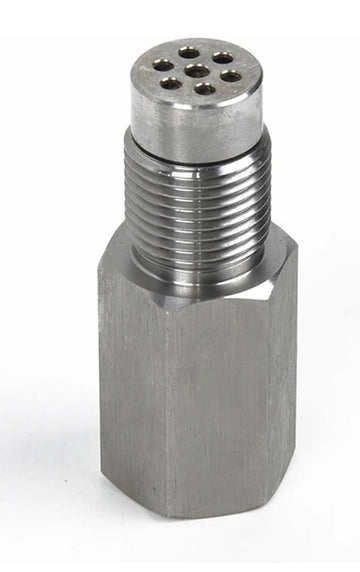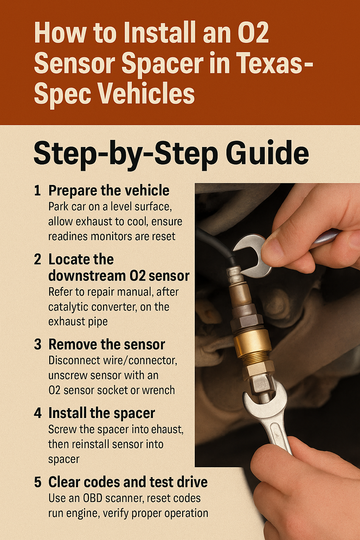Summary
In Iowa, where drivers navigate a blend of rural roads, windy highways, and varying seasonal climates, O₂ sensor spacers deliver key advantages—preventing check-engine lights, safeguarding catalytic converters, enabling off-road use, and supporting emissions compliance strategies. This article explores how oxygen sensor spacers work, their legal considerations in Iowa, installation tips for local conditions, real-world benefits, and provides a handy FAQ for mechanics, weekend racers, and emissions-conscious drivers.
Table of Contents
-
What Are O₂ Sensor Spacers?
-
How Do Oxygen Sensor Spacers Work?
-
Benefits of O₂ Sensor Spacers for Iowa Drivers
-
Preventing “Check Engine” Lights
-
Protecting Catalytic Converters
-
Supporting Off‑Road or Track Use
-
Handling Iowa’s Climate and Terrain
-
-
Legal Considerations in Iowa
-
Installation Tips for Iowa Vehicles
-
SEO‑Smart Keywords for O₂ Sensor Spacer Content
-
Related Content Ideas & Internal Linking Strategy
-
FAQ: Oxygen Sensor Spacers in Iowa
1. What Are O₂ Sensor Spacers?
O₂ sensor spacers—also called oxygen sensor extenders—are small tubular adapters fitted between the O₂ sensor and the exhaust bung. They shift the sensor slightly further downstream (usually by ½″ to 1″), positioning it in cooler exhaust gas and reducing its ability to accurately detect emissions.
These spacers are commonly used in:
-
Vehicles running aftermarket exhaust (e.g., larger pipes or flex sections).
-
Engines employing O₂ simulations or tuning for off‑road/racing purposes.
-
Drivers wanting to prevent post‑catalytic converter check‑engine codes without deleting parts.
2. How Do Oxygen Sensor Spacers Work?
-
Physical relocation – The spacer pushes the sensor further from the hot exhaust stream.
-
Rich‑lean masking – With cooler gases, the sensor reads slightly leaner than truth, which tricks the ECU into reducing fuel trim adjustments.
-
Code suppression – This helps avoid codes like P0420/P0430 (efficiency below threshold), common after exhaust mods.
-
Non‑destructive – Compared to programming ECUs or deleting cats, spacers are reversible and bolt‑on.
3. Benefits of O₂ Sensor Spacers for Iowa Drivers
a) Preventing “Check Engine” Lights
-
Common Scenario: In rural Iowa, farming trucks or pickups may run aftermarket exhaust for performance or cost. These often lead to false post‑catalytic code triggers.
-
Spacer Benefit: By offsetting the O₂ sensor readings, spacers help avoid CELs like P0420 (“catalyst system efficiency below threshold”) without sacrificing downstream emissions control entirely.
b) Protecting Catalytic Converters
-
Many Iowa motorists retrofitting Y‑pipes, straight pipes, or removing mufflers may experience surging that harms cats.
-
While spacers don’t eliminate the issue, they can reduce the ECU’s aggressiveness in running open loop fueling, offering some added protection.
c) Supporting Off‑Road or Track Use
-
Enthusiasts at track events—like amateur autocross on gravel or local drag points—often install high‑flow exhaust systems.
-
Spacers enable machines to run rich for power without triggering post‑cat codes during off‑road use; you can simply remove them when returning to regulated roads.
d) Handling Iowa’s Climate and Terrain
-
Cold winters: Cooler can lower exhaust gas temperatures even further; spacers can prevent sensor mis‑read, improving fuel economy during cold starts.
-
Dusty/gravel roads: Rural roads can increase particulate in the exhaust; spacers slightly distance the sensor from direct soot build-up, reducing maintenance.
4. Legal Considerations in Iowa
-
State emissions testing: Iowa doesn’t have statewide emissions testing beyond OBD‑II compliance during annual safety inspections.
-
Street‑legal vs. off‑road: Using spacers to mask emissions issues may raise concerns during emissions enforcement—but they are less conspicuous than deleting or replacing the catalytic converter.
-
Recommendation: Use O₂ spacers judiciously and revert to stock when performing official inspections. Always pair with properly functioning catalytic converters and keep documents of compliance.
5. Installation Tips for Iowa Vehicles
-
Pre‑installation check: Ensure the spacer fits the specific thread pitch and bung size used by your O₂ sensor.
-
Torque properly: Use anti‑seize (light amount) and torque to manufacturer spec—typically around 25–35 ft‑lb.
-
Temperature compatibility: Choose spacers rated for high temp (≥ 1000 °F), especially helpful in cold‑heavy cycling (winter start‑stops).
-
Periodic checks: Inspect for exhaust leaks—especially important on uneven Iowa roads, where frame flex can loosen fittings.
6. SEO‑Smart Keywords for O₂ Sensor Spacer Content
To optimize search ranking for Ghaly Motor Parts, use these keywords with natural density (about 1‑2%):
-
Oxygen sensor spacer Iowa
-
O₂ sensor extenders
-
Cat code blocker Iowa
-
Check engine light spacer fix
-
OBD‑II spacer on rural haul trucks
-
Exhaust mod for farm trucks
Consider long‑tail phrases for blog titles:
-
“How O₂ Sensor Spacers Help Iowa Farmers Avoid CELs After Exhaust Mods”
-
“Best O₂ Extenders for Des Moines Commuters with Aftermarket Exhaust”
7. Related Content Ideas & Internal Linking Strategy
| Topic | Purpose / Link Strategy |
|---|---|
| “How to choose the right O₂ sensor spacer” | Link early in blog for “choose” anchor text |
| “Step‑by‑step O₂ spacer installation guide” | Anchor “installation” |
| “Legal emissions mods in Iowa: What’s allowed?” | Anchor “legal considerations” |
| “Aftermarket exhaust options for Midwest trucks” | Link for rural‑oriented readers |
| “When to remove O₂ spacers for inspection” | Encourages return visits and trust |
8. FAQ: Oxygen Sensor Spacers in Iowa
Q1: Are O₂ sensor spacers legal in Iowa?
-
Technically yes, but you’ll want to revert to stock settings before any official emissions or repair inspections to stay compliant.
Q2: My car still throws a code after installing a spacer—what now?
-
Spacers can only mask mild efficiency discrepancies. If there’s a genuine catalytic failure or rich/lean fault, you’ll still get codes. Address root mechanical problems first.
Q3: Do I need a custom tune if using an O₂ sensor spacer?
-
In many cases, no. Spacers act as passive code blockers. For aggressive tune setups (like E85 or big cams), a proper ECU tune is still recommended.
Q4: Can I drive year‑round with a spacer in place in Iowa?
-
Yes—though in winter, the cooler ambient temps can make sensors read even leaner. Monitor drivability and consider removing it for diagnostic clarity prior to emissions checks.
Q5: Will using a spacer void my warranty or damage my vehicle?
-
Because they’re bolt‑on and reversible, spacers generally don’t void warranties. Still, tampering under emissions control could be disputed—keep your stock parts and reinstall if needed.
-
Closing Thoughts
For Iowa drivers who tweak their exhaust for performance or sound—whether farm trucks, off‑road rigs, or track toys—O₂ sensor spacers bring practical benefits. They help prevent unwanted “check engine” codes, reduce unnecessary catalytic stress, and can blend into everyday driving seamlessly. Use them wisely, stay informed about local regulations, and link to Ghaly Motor Parts’ tutorials and product pages for user help!


![ Fix P0420 Fast: Do O2 Sensor Spacers Really Work? [Legal Tips Inside]](http://ghalysmotorparts.com/cdn/shop/articles/ChatGPT_Image_Oct_10_2025_10_40_32_AM.png?v=1760118069&width=360)
![Do O2 Sensor Spacers Really Help Clear the P0420 Code? [Expert Guide]](http://ghalysmotorparts.com/cdn/shop/articles/ChatGPT_Image_Oct_9_2025_09_28_33_PM_654c1798-c0d4-428f-a5b6-f20b95661b54.png?v=1760129952&width=360)


